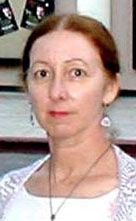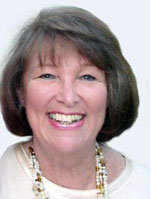|
San
Diego Jewish World
Sunday evening, August
5
Vol. 1, Number
97
Technion
scientist develops theoretical time machine:
it would help travelers from future come to our time
HAIFA
(Press Release)—Technion researchers have developed a theoretical model of a
time machine that, in the distant future, could possibly enable future
generations to travel into the past. An article on this was published last week
in the scientific journal Physical Review.
“In order
to travel back in time, the spacetime structure must be engineered
appropriately,” explains Prof. Amos Ori of the Technion’s Faculty of Physics.
“This is what Einstein’s theory of general relativity deals with. It says that
spacetime can be flat. That is – it has a trivial, simple structure. But it can
also be curved with various configurations. According to the theory of
relativity, the essence of gravitational fields is in the curving of spacetime.
The theory of relativity also defines how space is curved and how this curvature
develops over time.”
|
San Diego Jewish World
August
5, 2007
(click on headline below to jump
to the story)
Israel and Middle East
Technion
scientist develops theoretical time machine:
it would help travelers from future come to our time
IDF
Class, including women, begins Artillery Corps training
European Socialists to be briefed on Middle East
Hebrew University
reaches agreement to market
drug for epilepsy, other neurological disorders
Tel Aviv University announces device to improve gas mileage on trucks
traveling at highway speeds
Genes to 'broadcast' their
'news' via MRI readings
Israel Guide Dog Center for the Blind is now a
tzedakah project for bar and bat mitzvah students
Features
News sleuths
Sports
Lightning batters fan 11 times, yet still win 3-2
Arts &
Entertainment
The
disciplines of Torah.... and of the ballet
Margulies'
Sight Unseen
should
not be left unseen
|
The main
question is – if according to the principles of curvature development in the
theory of relativity - can a time machine be created? In other words – can we
cause spacetime to curve in such a way as to enable travel back in time? Such a
journey requires a significant curvature of spacetime, in a very special form.
Traveling
back in time is actually closing time-like curves so we can go back to an event
at which we were present in the past. In flat space, it is not possible to close
curves and go back in time. In order for closed time-like curves to exist, there
has to be a curvature of a specific form on spacetime.
The
question Prof. Ori is investigating is – do the laws of gravity permit the
development of spacetime with the required curvature (closed time-like curves)?
In the past, scientists raised a number of objections to this possibility. Now,
Prof. Ori is proposing a theoretical model for spacetime that could develop into
a time machine.
|
|
The model overcomes some of the questions, which, until now,
scientists have not succeeded in solving. One of the difficult
claims against a time machine was that, in order to create a
time machine, it would be necessary for it to contain material
with negative density. And since we do not have such material –
and it is also not clear if the laws of nature enable the
existence of such material in the quantities required - it is
not possible to build a time machine. Now, Prof. Ori comes along
and proposes a theoretical model that does not require material
with negative density. The model that he proposes is,
essentially, a vacuum space that contains a region field with
standard positive density material.
“The machine is spacetime itself,” he explains. “Today, if we
were to create a time machine – an area with a warp like this in
space that would enable time lines to close on themselves – it
might enable future generations to return to visit our time. We,
apparently, cannot return to previous ages because our
predecessors did not create this infrastructure for us.”
Prof. Ori emphasizes that we still do not have the technology to
control gravitational fields at will, despite the fact that the
theoretical principles of how to do this exist. “The model that
we developed at the Technion is a significant step but there
still remains a number of non-trivial open questions,” he
stresses.
“It may be that some of these questions also will not be solved
in the future. This is still not clear.” As an example, he
brings up the problem of instability according to which in
spacetime with a time machine there could be disturbances with
increasing strength so that spacetime would be disrupted to such
an extent that it would cancel out the time machine. Prof. Ori,
one of the few scientists in the world investigating this issue,
hopes that continued research will present a clearer picture
with respect to these questions.

(Return to top)
IDF
Class, including women, begins Artillery Corps training
By
Dor Blech
SHIVTA, Israel (Press Release)—Hundreds of new
soldiers will arrive at the Artillery Corps School here in order to begin their
training as part of the firepower of the IDF today.
The Combat Soldier’s training course takes place over approximately a year, in
which the soldiers of the corps are split up into many different
specializations. At the end of the course, the soldiers are designated for the
battalions of the corps, according to the specialization training which they had
completed. The Artillery Corps operated day and night during the Second Lebanon
War, and received much accolades.
The girls of the corps serve either as instructors in the Moran special
artillery unit, or as combat soldiers in the ‘Mantez’ Battalion which took a
significant part in last summer’s war.
“It does not bother me that I will be required to serve for three years,” says
Luba as she tries on military boots for the first time. “I was looking for a
meaningful military service, and as a combat soldier I will contribute that much
more, for a longer period of time.”
Iris, parts from her daughter Sarit, as she boards the bus which will take her
to the enlistment chain. “I am very proud of her,” she says. “She is very
special, she was absolutely certain that she would serve in a significant
position which would contribute as much as possible, and where she could fulfill
her values.
“She is my eldest daughter. … Her father and I support her as much as possible.
She was a scout and made a contribution, and in the military she is looking to
contribute as much as possible as well. It is strange to me, from the moment she
was born, until now, I never thought about the fact that she would enlist.”
The preceding story was provided by the
Israel Defense Force
(Return to top)
|

European Socialists to be briefed on Middle East
JERUSALEM (Press Release)—Vice Prime Minister and Minister of Foreign
Affairs Tzipi Livni will meet tomorrow (Monday, August 6) with the
co-chairmen of the Middle East Committee of the Socialist International,
Norwegian Foreign Minister Jonas Gahr Store and Secretary of the Italian
Democratic Party of the Left, Piero Fassino.
The meeting will focus on regional developments, on the political process
and on the Norwegian initiative to re-establish the contributory forum to
the Ad Hoc Liaison Committee (AHLC).
The visit is to take place within the framework of an updating tour, during
which they will meet with President Shimon Peres, Minister of Defense and
Chairman of the Labor Party Ehud Barak and with Labor and Meretz Party
Knesset members.
The preceding story was provided by Israel’s Ministry of
Foreign Affairs
(Return to top)
.
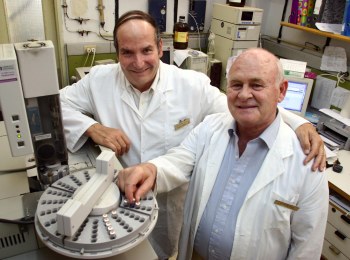
BIOSCIENTISTS—Prof. Meir Bialer (left) and Prof. Boris Yagen in their
lab
Photo: Sasson Tiram
Hebrew University
reaches agreement to market
drug for epilepsy, other neurological disorders
JERUSALEM (Press Release)—Yissum, the technology transfer company of the
Hebrew University of Jerusalem, has entered into a worldwide licensing
agreement with Neurocrine Biosciences Inc. for the development and
commercialization of valnoctamide stereoisomers. Valnoctamide and its
individual stereoisomers have been shown to be active in a number of
preclinical models and have the potential to treat epilepsy, bipolar
disease and neuropathic pain.
A stereoisomer is a molecule containing the same number and kind of
atomic groupings as another but having a different spatial arrangement,
thus exhibiting different properties.
The parent compound is a uniform combination of four valnoctamide
stereoisomers that has been marketed as an anxiolytic in several
European countries.
While from the same chemical class as valproate (e.g. Depakote ® and
Depakene®), a leading antiepileptic drug (AED) currently approved for
use in the treatment of epilepsy, migraine prophylaxis and bipolar
disease, this version of valnoctamide has not been associated in
preclinical studies completed to date with the safety concerns (i.e.
teratogenicity, and hepatotoxicity) of valproate and its related
analogues.
The clinical development of one of the stereoisomers of valnoctamide is
intended to offer patients suffering from neurological and psychiatric
disorders, a safer and
potentially more efficacious treatment option. Neurocrine intends to
initiate clinical
studies after submission of an investigational new drug (IND)
application in the first half of 2008.
“This stereoisomer of valnoctamide may provide the opportunity to
address many of the current unmet medical needs in the area of neurology
and psychiatry by offering patients and their physicians a unique new
product profile. We look forward to initiating a clinical development
program and plan to file our IND in the first half of 2008,” said
Christopher F. O’Brien M.D., senior vice president and chief medical
officer of Neurocrine.
“Due to its side effects, the use of valproate is restricted in women of
child bearing age and in children. The development of valnoctamide
stereoisomers may provide more efficacious and safer CNS drugs and a
suitable answer for these clinical needs across all patient types,” said
Meir Bialer, David H. Eisenberg Professor of Pharmacy at the Hebrew
University of Jerusalem.
Bialer, together with Prof. Boris Yagen of the Hebrew University, have
guided the discovery of the chemical and biological properties of
valnoctamide and its individual stereoisomers. Bialer is a leader in the
discovery of antiepileptic agents and has authored over 190 publications
in the area of pharmacokinetics, antiepileptics and CNS drugs.
“We are delighted with this first-ever cooperative agreement with
Neocrine,” said Nava Swersky-Sofer, president and CEO of Yissum. “We
congratulate Professors Bialer and Yagen on the fruits of their research
and we are proud of the confidence shown by Neurocrine in the
valnoctamide stereoisomers.”
According to IMS Health, sales of valproate derived branded and generic
products
exceeded $1.5 billion in the U.S. alone for 2006. With indications
possible in therapeutic categories ranging from neurology (epilepsy,
migraine pain, and neuropathic pain) to psychiatry (bipolar disorder),
commercialization of a stereoisomer of valnoctamide provides the
opportunity to access markets accounting for more than $15 billion in
drug sales (Med Ad News, 2006) and in excess of 50 million patients
(Mattson Jack Group, 2007) on a worldwide basis.
Neurocrine Biosciences, Inc. is a product-based biopharmaceutical
company focused on neurological and endocrine diseases and disorders.
The product candidates address some of the largest pharmaceutical
markets in the world, including insomnia, anxiety,
depression, endometriosis, irritable bowel syndrome, pain and diabetes.
The preceding story was provided by Hebrew
University
(Return to top)
|
Dear Readers,
Along with my husband Don, I co-publish
San Diego Jewish World. As a couple we have gone to many
places. Cruising ranks at the top of our list of favorite ways
to travel.
Watch this ad for a
different cruising photo each day. A similar adventure can be yours!
America's
Vacation Center, with which I'm
affiliated, is a multi-branched travel agency that is able to
provide you both good prices
and
good service. Before you book anywhere else, please ask me for
a price comparison.
Please call me at
(619) 265-0808 for information about booking a cruise from San
Diego or anywhere. Or email me at
sdheritage@cox.net
Thank you!
Nancy Harrison
 |
Adventures in Cruising—Royal
Caribbean's Monarch of the Seas
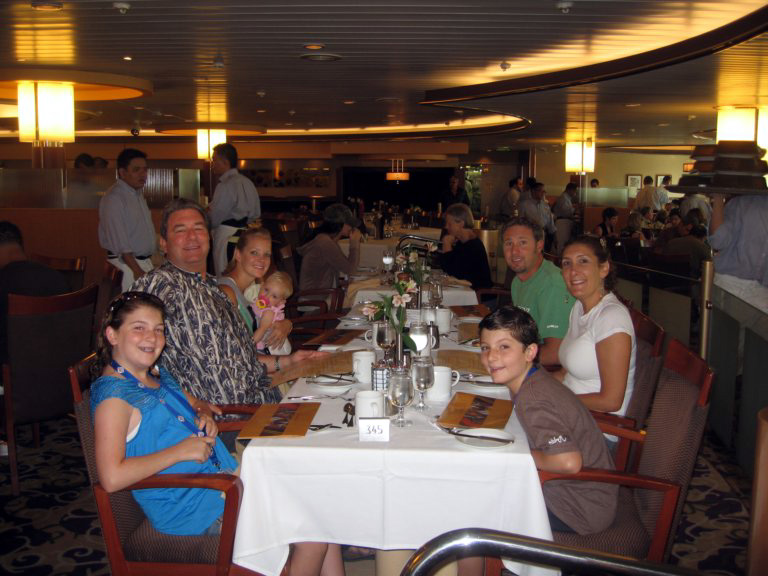
Table for Seven—The Ford family dines together aboard the Monarch of
the Seas: Left from front: Ashlee, Craig, Lisa, Taylor. Right from
front: Tyler, Caren, Kevin.
Thanks to the Ford
family of Agoura, California, for sharing their photos of
their family reunion weekend cruise
|
Tel Aviv University announces device to improve gas mileage on trucks
traveling at highway speeds
TEL
AVIV (Press Release) American investors and entrepreneurs are paying
close attention to the results of research conducted at the TAU
Fleishman Faculty of
Engineering
on improving the aerodynamics of heavy trucks, which could potentially
save the world transportation industry hundreds of millions of gallons
of fuel and reduce the production of "green house" gases. The potential
benefits are a result of the huge impact (about 65%) the air flow
resistance has on the fuel consumption of large vehicles driving at
highway speeds for long distances.
Tel-Aviv University (TAU) has developed an aerodynamic "drag"
(resistance) reduction device resulting in decreased fuel consumption
and environmentally important reduction in the burning of fossil fuels.
The device that can be fitted as an add-on to the back side of a truck
or its trailer is designed to reduce fuel by as much as 10%. Naturally,
this reduction in the use of fossil fuels will have a significant
economical, environmental and possibly political impact.
Prof. Avraham Seifert and his co-researchers from TAU’s Meadow
aerodynamics laboratory at the Iby and Aladar Fleischman Faculty of
Engineering are currently testing a small actuator which, when scaled
up, can be attached to the periphery of the rear-end of a truck or its
trailer. By the combined action of suction and pulsed blowing of
airflow, the device reduces drag in a controlled manner, due to
increased pressure on the back of the truck. At an expected end-user
cost of a couple thousand dollars per unit, the device is expected to
return the investment relatively quickly, about a year or two, for
trucks riding some 50,000 miles for long distances on highways per year.
Resulting from several focused research projects, “Prof. Seifert’s
device not only saves energy, but can extend the range and improve the
performance of aircraft and other fluid related systems as well,” says
Prof. Ehud Heyman, the Dean of the Faculty of Engineering at TAU
"This research is an example of unique innovation and focused effort
spent by a group of our most dedicated scientists and engineers at a
very difficult time to Israeli universities in general and Mechanical
engineering in particular,” says Prof. Lev Shemer, the head of the
school of Mechanical Engineering at TAU, who witnessed the first
operation of the actuator developed by Prof. Seifert and Mr. Shlomo
Paster in October 2003.
The device was presented on May 16, at the annual showcase in Fort
Worth, Texas. The audience included entrepreneurs, investors and Fortune
500 companies. Each year the showcase offers an unparalleled forum that
is both deal-focused and unbiased with regard to geography, funding
source or originating research institution. Participating technologies
are selected by - and presented to - over 100 seasoned venture investors
and licensing scouts representing a variety of industries, each
supported by private funding, federal R&D grants or both.
“We were approached by a group of American angel investors at the
conference and we have subsequently met with them in Israel,” says Larry
Loev, Director, Business Development for Engineering and Physical
Science Ramot at Tel Aviv University Ltd. “We are at the beginning of
the negotiation stage and if all goes according to plan, a prototype
could be ready for road tests by as early as next year.”
T he
preceding story was provided by Tel Aviv University
(Return to top)
.
Genes to 'broadcast' their
'news' via MRI readings
REHOVOT, Israel
(Press Release)—To help molecular biologists in the difficult
task of keeping abreast of current events in the world of cells
and organisms, they employ reporter genes to 'broadcast'
specific happenings. For example, if a scientist is interested
in the whereabouts and activities of a certain gene, the
reporter 'follows' it, and when this gene is activated in any
way, the reporter gene produces an easily detectable protein,
such as green fluorescent protein (GFP). The scientists are then
able to 'read' this 'report' and learn about the specific events
that are occurring and in what regions.
The light given off by
these proteins is scattered in the tissue, however, reducing the
resolution of many images. An alternative to fluorescent
proteins is reporters that would be detectable via magnetic
resonance imaging (MRI). But for most of the candidate reporters
proposed so far, a second material needs to be administered in
addition to the reporter gene to allow the MRI to detect its
signals. Unfortunately, processes such as fetal development and
those that take place within the central nervous system present
barriers to these additional substances.
Prof. Michal Neeman and
Dr. Batya Cohen of the Weizmann Institute’s Biological
Regulation Department, along with Ph.D. students Keren Ziv and
Vicki Plaks and colleagues, have now developed genetically
modified mice that carry a promising candidate reporter named
ferritin, which could circumvent these problems. Ferritin works
by sequestering iron from cells. When it is overexpressed, iron
uptake increases, causing signal changes in the surrounding
environment that can be detected by MRI, without the need to
administer an additional substance.
As recently described in
the journal Nature Medicine, ferritin has so far
successfully broadcast live reports via MRI detection from the
liver, endothelial cells and even during fetal development in
pregnant mice, without the need for additional substances.
Prof. Michal Neeman’s
research is supported by the Clore Center for Biological
Physics. Prof. Neeman is the incumbent of the Helen and Morris
Mauerberger Chair in Biological Sciences.
The Weizmann Institute of
Science in Rehovot, Israel, is one of the world's top-ranking
multidisciplinary research institutions. Noted for its
wide-ranging exploration of the natural and exact sciences, the
Institute is home to 2,600 scientists, students, technicians and
supporting staff. Institute research efforts include the search
for new ways of fighting disease and hunger, examining leading
questions in mathematics and computer science, probing the
physics of matter and the universe, creating novel materials and
developing new strategies for protecting the environment.
The
preceding story was provided by the Weizmann Institute of
Science
(Return to top)
________________________

Click the ad above to go to the "I'm there for you baby" website
Israel Guide Dog
Center for the Blind is now a
tzedakah project for bar and bat mitzvah students
BEIT OVED, Israel (Press
Release)—As Bar and Bat Mitzvah students across North America
prepare for one of the most momentous occasions in their Jewish
lives, they are encouraged to take on a Jewish community service
project to supplement their studies. Such projects have come to
be known as Mitzvah or Tzedakah Projects. One cause that’s been
gaining attention and popularity among students is a guide dog
sponsorship program with The Israel Guide Dog Center for the
Blind (IGDCB) here.

Guide
dog in training |
Through this rewarding
experience, students learn first-hand about helping
visually impaired Israelis gain independence, mobility
and freedom through guide dog partnership. It’s
typically a two-year program, during which time the
student raises $500 to go towards food and care for the
future guide dog. The money is typically raised through
baby sitting, working odd jobs, doing chores around the
house and asking relatives for donations. If in the end
they haven’t reached their goal, they may choose to
apply a portion of their gifts to reach the goal. In the
process, the students develop a meaningful tie with
Israel.
Guide dogs are
becoming a more familiar sight in cities and towns
throughout Israel thanks to the efforts of The Israel
Guide Dog Center for the Blind. The dogs move alertly
through sidewalk traffic, guide their owners to work, to
the bank, to the market—even for a walk on the beach.
|
They squeeze into revolving doors
without complaint, walk around obstacles at street corners and
are virtually invisible as they lay beneath restaurant tables,
waiting for their next command. They even warn their human
partners about cutout curbs that are so helpful for wheelchairs
but so lethal for the blind, who count on curbs as street
alarms.
The guide dog process begins with
a new litter of puppies who stay with their mother for two
months and are then placed in the homes of puppy-raising
families where they learn socialization and other skills to help
assure that they will be acceptable for guide dog training. The
goal of these foster families is to lavish love and teach the
puppies how to learn. They romp and play and sleep by the bed.
They learn right from left and right from wrong. No begging at
the table, no sleeping on couches and no chasing cats. These
dogs must learn discipline, but also lead happy, active lives.
It all looks easy, but getting there takes a lot of work and
training. It involves hundreds of miles of walking, a lot of
perseverance, a ton of patience, a dose of fear and even a few
tears, but the puppy-raisers say it’s all worth it.
When guide dog owner Moti
Barzilai was asked how his dog changed his life, he commented
that his Chocolate Lab guide dog, Charlie, did more than change
his life, “he revolutionized it.” Moti travels by bus from Sefad
to the guide dog center in Beit Oved, making one change at the
Central Bus Station in Tel Aviv. Of the three methods of
mobility—a human guide, a long cane and a guide dog—guide dog
users like Moti agree: guide dogs enable them to achieve a whole
new level of empowerment.
As Puppy Sponsors, students learn
about the vital relationship between a guide dog and a blind
Israeli. Everything from companionship to the new-found active
and independent lifestyle made possible through the pairing.
Then, at the end of their Bar and Bat Mitzvah studies, the
student sponsors share their project experiences with their
congregation, explaining how they have grown through this
process and what they have learned about assisting the Jewish
community. It’s quite a rewarding and emotional project for all
involved, as well as a wonderful introduction for these young
adults to feel a part of the Jewish community both at home and
in the State of Israel.
The Israel Guide Dog Center for
the Blind is in Beit Oved, just a twenty-minute drive south of
Tel Aviv near Rehovot. For further information about this
Mitzvah Project, call 267-927-0205, E-mail
igdcb@nni.com, visit their website:
www.israelguidedog.org
or write to the American branch of Israel Guide Dog Center for
the Blind, 732 S. Settlers Circle, Warrington, PA 18976.
Return to top)
|
  News Sleuths: News Sleuths:
Watching the media gathering
and reporting the news
of Jewish interest
|
(Editor's Note: Back from the Middle East,
U.S.
Secretary of State Condoleeza Rice was a guest interviewee
on Sunday morning television news shows. The State
Department provided transcripts of her interviews, and we
here excerpt those questions and answers relating to the
proposed Saudi arms deal):
Fox News Sunday with Chris Wallace:
QUESTION: The President has just announced a $20 billion arms
sale of sophisticated weapons to Saudi Arabia and other Gulf states. But
according to the New York Times, U.S. officials feel the Saudis
have worked against the Iraqi Government, are currently funding Sunni
insurgent groups, and that the majority of suicide bombers in Iraq are
actually Saudi. Secretary Rice, given what our own UN Ambassador calls
the "destabilizing policies" on the part of Saudi Arabia, why would we
be selling them more sophisticated weapons?
SECRETARY RICE: Well, let's remember that the United States has had
interests in security cooperation in this region for decades; there is
nothing new in this. And certainly, we want our allies and strategic
partners in the region to be well defended. It would make no sense to
leave Saudi Arabia or the other Gulf states undefended -- incapable of
defending themselves -- or turning to others who might be less reliable
in providing for their defense at a time when the security challenges in
that region are increasing.
Now as to
political cooperation with Saudi Arabia, we have -- I've just been in
Saudi Arabia, talking with the Saudis and with the Gulf states, Egypt
and Jordan, about all of our obligations to a Iraq that is unified. I
think these are states that understand that an Iraq that is unified is
in their interest; indeed, it's in their vital interest. And I also
would note that the Saudi Government announced that it's going to put an
embassy in Baghdad; something that we have hoped they would do for quite
some time. They're working to forgive the debt of Iraq and they're
working with these local tribes -- some of whom have relatives across
the Saudi border -- to try and reinforce the need for Sunnis to be fully
integrated in and fully active in the policies of Iraq.
And so I
simply think that we have good cooperation. We want all of the states,
all of the neighbors to do more. But it makes no sense to leave our
longtime strategic allies undefended in a region in which Iranian and
other challenges are growing.
CBS Face the Nation with
Bob Schieffer:
QUESTION: Madame Secretary, well, let's shift then to Iraq. You are
just back from the region out there, trying to find a way to encourage
Iraq's neighbors to take more of a stance and lend more support to the
United States' efforts to somehow find some in to what is going on
there. One of the things you did is propose an enormous arms sale to the
Saudi -- to the Saudis.
Back
home, people in the Congress -- they created something of an uproar.
Some hundred or so members of Congress have now signed a letter asking
you not to do this. They're warning it could set off some sort of an
arms race in the Middle East. Why did you do this, and why is this a
good thing?
SECRETARY RICE: Well, this effort to have security cooperation and
to help provide for the defense of our allies goes back decades. The
relationship between Saudi Arabia and the Gulf states -- and by the way,
it's not just Saudi Arabia, it's several of the Gulf states -- does go
back decades, and it's because America has important interests in the
region that need to be defended. And it doesn't make sense that our
friends and allies would be undefended, or that they would have to rely
on somebody else for the supply of goods for their defense at a time of
growing challenge in this region.
I
don't think anybody doubts that Iran constitutes a major challenge,
security challenge, to our friends, our allies and therefore to our
interests in the Gulf region. And we will be briefing the Congress. We
will work with the Congress. We believe we've constructed these security
cooperation packages with the Gulf states; with Israel, by the way,
where we are now going to start a new ten-year program; with Egypt,
where we will start a new ten-year program.
But
the United States has had security interests in this region for decades.
And we need to be able to be a reliable security partner for our
friends.
QUESTION: Do you believe that Saudi Arabia is doing all it can to
block militants from crossing the border into Iraq, because, as we hear
it, most of the foreign fighters who are coming into Iraq are coming
across the Saudi border.
SECRETARY RICE: Well, we believe that the most unguarded situation
is really with Syria, where people are not just crawling across the
border, they're coming in through the Damascus airport. That could be
cut off if the Syrians wish to do it. One of the reasons they're coming
in through the Damascus airport is that the Saudis are working on the
border to try and cut off the flow of foreign fighters. It's a difficult
border to defend.
One of
the issues that the Saudis raised with me is: better security
cooperation between the United States -- or the multinational forces --
Iraq and Saudi Arabia to try and really deal with that border. The
Saudis also noted, while I was there, that they're going to put an
embassy in Baghdad. We've been asking for that from Arab states for some
time; I think that's a step forward. And the Saudis have been active in
engaging Sunni tribes -- many of whom have ties of kinship across the
borders between Iraq and its neighbors -- to really be active in the
political life of the country.
And so
yes, there is more that all of Iraq's neighbors can do. And that's why
we had the Sharm neighbors conference; is to emphasize that. But we're
working with those neighbors, and all of them understand that a stable
Iraq is going to be in their interests and an unstable one is going to
threaten their interests.
The preceding transcripts were
provided by the U.S. State Department

California, Arizona & Nevada
sales positions
Start your career, help save the planet
 The
foremost environmentally friendly packaging company, Bubbla,
seeks sales personnel throughout the three-state area to
demonstrate and sell its packaging systems. We offer sales
assistance, payment for pre-qualified customer demonstrations
and a high commission structure for independent representatives.
To find out more, email us at
acooper@bubbla.com, or
call our offices in Canoga Park at (818) 884-2000, or click on
this link to visit our website
http://www.bubbla.com
(go to the "contact us" tab). The
foremost environmentally friendly packaging company, Bubbla,
seeks sales personnel throughout the three-state area to
demonstrate and sell its packaging systems. We offer sales
assistance, payment for pre-qualified customer demonstrations
and a high commission structure for independent representatives.
To find out more, email us at
acooper@bubbla.com, or
call our offices in Canoga Park at (818) 884-2000, or click on
this link to visit our website
http://www.bubbla.com
(go to the "contact us" tab).
7931 Deering Ave. Los Angeles, CA 91304 Toll Fee
(877) 4-Bubbla Fax (818) 883-2164 info@bubbla.comhttp://www.bubbla.com
|

{Click the above ad for more
information}

News from the
Israel Baseball League |
Lightning batters fan 11 times, yet still win 3-2
By Nathaniel Edelstein
KIBBUTZ GEZER, Israel (Press Release)— Maximo Nelson fanned 11
batters in seven innings of work, but it wasn't enough to beat the
Tel Aviv Lightning as the Modi'in Miracle lost 3-2 on Sunday night.
The three runs came on solo homers from shortstop Raul Franco, third
baseman Nate Fish, and first baseman Stuart Brito, who had two hits
on the game. Australian Adam Crabb pitched 4 1/3 innings and
allowed just one earned run before giving way to New York native
Mike Etkin, who picked up the win.
Miracle first baseman Aaron Levin went 4-for-4 as Modi'in lost its
third consecutive game and Tel Aviv won for the fourth straight
time.
Meanwhile at the Sportek in Tel Aviv the Bet Shemesh Blue Sox beat
the Netanya Tigers 7-4. The Blue Sox only had three hits, but
scored five runs in the first inning on a combination of walks, hit
batsmen, errors, a passed ball, and a wild pitch. Netanya's
Colombian pitcher Rafael Rojano left after just one inning before
Israeli Shlomo Lipetz
took over and threw six innings, giving up no runs on one hit while
striking out 11 and walking one.
But righty Jason Benson kept Bet Shemesh in it with a complete game,
allowing two earned runs on seven hits while striking out three and
walking none. Australian rightfielder Jason Rees slugged his
league-leading 15th homerun of the season.
At the Baptist Village the last-place Petach Tikva Pioneers lost
their seventh straight game, going down at the hands of the Ra'anana
Express in a 16-1 laugher called due to darkness after five innings.
Express shortstop Brendan Rubenstein went 4-for-5 with five RBI and
three runs scored and first baseman Scott Feller went 3-for-3 with
two RBI. All but two Ra'anana starting position players had at
least one hit.
Express right-hander Nathan Mittag pitched all five innings and
allowed only one run on three hits, striking out three batters and
walking two. The win is the third in a row for manager Shaun
Smith's club.
Before Monday's games the Modi'in Miracle will tour the city they
represent with Modi'in Deputy Mayor Alex Weinreb. The tour will
begin at 10:30 am and conclude at noon when the Miracle will return
to City Hall to meet with fans and give away souvenirs and tickets.
Manager Art Shamsky also will be speaking with fans and children
aboutbaseball fundamentals to help young Israelis become future IBL
stars.
On Tuesday, August 7 at 11:30 am to 1:30 pm players from the Netanya
Tigers will be visiting the Hadarim Mall in Netanya. Netanyaplayers
who hail from Israel, the United States, the Dominican Republic,
Colombia, Australia and Japan will have a "meet and greet" with
fans. Players will be handing out free tickets to games and there
will also be fun activities with prizes for fans. Also, in
attendance will be Netanya Manager and Israel's own Ami Baran.
Summaries:
1 2 3 4 5 6 7 R H E
Tel Aviv 0 1 1 1 0 0 0 3 7 2
Modi'in 0 2 0 0 0 0 0 2 9 0
W: Mike Etkin (3-0); L: Maximo Nelson (5-2); HR: Nate Fish (2), Raul
Franco (4), Stewart Perez Brito (3)
1 2 3 4 5 6 7 R H E
Bet Shemesh 5 2 0 0 0 0 0 7 3 3
Netanya 0 0 0 2 0 1 1 4 7 1
W: Jason Benson (5-1); L: Rafael Rojano (2-3); HR: Jason Rees (15),
Ryan Forsythe (1)
1 2 3 4 5 R H E
Petach Tikva 0 1 0 0 0 1 3 2
Tel Aviv 2 4 5 4 1 16 16 1
W: Nathan Mittag (2-2); L: Ari Alexenberg (0-5); HR: None.
Standings:
Team W L % GB
Bet Shemesh Blue Sox 23 8 .742 –
Tel Aviv Lightning 21 9 .700 1.5
Modi'in Miracle 18 13 .581 5.0
Ra'anana Express 13 18 .419 10.0
Netanya Tigers 11 18 .379 11.0
Petach Tikva Pioneers 5 25 .167 17.5
Today at 4:30 pm at the Sportek in Tel Aviv the Bet Shemesh Blue Sox
and the Netanya Tigers play the last half-inning of the July 1st
protested game before playing their regularly scheduled game at
5pm. Also at 5 pm the Modi'in Miracle host the Ra'anana Express at
Kibbutz Gezer and at 7 pm the Tel Aviv Lightning and the PetachTikva
Pioneers play at Yarkon Field at the Baptist Village.
The preceding story was provided by the Israel Baseball League

{Click the above ad for
more information}

{Marc Kligman, who combines being
a sports agent with his life as an observant Jew, invites you to listen.
Click on the ad above for more information}
The
disciplines of Torah.... and of the ballet
(Editor's
Note: We have combined into a single
magazine-length
article a three-part story by Sheila Orysiek in
which, in the first part, she compares the discipline of Torah study with that
of ballet; in the second part, she observes and reports upon the teaching style
of Susan Jaffe, a Jewish Prima Ballerina who for 20 years was a Principal Dancer
for the American Ballet Theatre {ABT}; and in the final part, she
interviews Jaffe about her new role and techniques as a teacher.)
SAN DIEGO—The dedication of scholars
of the Torah is legendary; starting at an early age – it never
ends. In a cheder, properly dressed, they greet the teacher with
utter respect, begin with a blessing and prepare for a long day of
study. Across the world (Occident, Orient and in between) ballet
students gather in studios, properly dressed, greet the teacher with
a reverence (bow/curtsy) and begin their day with the basics from
which even the most glorious dancer never graduates. After the
applause of the previous night, before the flowers have begun to
wilt, the ballet dancer is back in class the next morning to be
corrected; a humbling experience on a daily basis.
Torah is not learned alone – it is
studied in a group setting; so, too, the classical dance. It cannot
be self-taught – the body misinforms the mind, misleading it and
ultimately undermining it. Private lessons are not sufficient; the
dancer must learn to relate to others in space. The Torah directs
us how to relate within a community – there is no need for a civil
structure when one lives alone. Just as Torah is transmitted from
teacher to student – correcting pronunciation, presenting concepts,
the teacher shaping and sharpening the mental capacity of the
student; a ballet teacher shapes a foot, turns a hand, tilts a head
and teaches the student to discipline both mind and body.
The Torah student is aware of the
long line of historical scholarship, the commentaries inform his
thought. The ballet dancer is the product of centuries of study and
structure; the achievements of those who came before influencing how
the dance is taught and presented.
Hebrew binds together a people
dispersed to virtually every corner of the earth speaking hundreds
of different languages. Hebrew has always been the binding thread,
giving entry to the history the people carried on their backs as
well as a living language today. Enter a synagogue in an uncharted
village and the worshipper at Shabbat services may sing a different
tune, but will pray essentially the same words. The ballet was born
in Italy, codified in France, thus French is the language through
which dancers communicate with one another no matter where they go
to study or perform. An Israeli ballet dancer taking class in Ulan
Bator (yes, there is ballet in Mongolia) will understand what is
being taught.
After the Torah student finishes
reading Deuteronomy he (or she) returns again to Genesis. Every day
at the barre the ballet dancer starts once again with pliés and
tendus. There is a prescribed order - a unifying structure. Judaism
has Ten Commandments – ballet has Five Positions. Judaism has 613
Mitzvot – ballet has almost that many variations of pas de bourrée
(a series of three small steps).
Sometimes the Torah Student finds it
advantageous to study with another teacher or a visiting scholar
will join the group. Recognizing the benefit of this concept, a
serious ballet school will often invite in another – or several –
guest teachers to come to teach a “summer intensive.”
City Ballet of San Diego, founded and
directed by Stephen and Elizabeth Wistrich, has
invited in three such renowned guest teachers:
Susan Jaffe:
retired Principal Dancer, American Ballet Theatre; David Howard,
internationally recognized ballet teacher; Evelyn Cisneros: retired
Principal Dancer, San Francisco Ballet.
|
My Observations of the
Class
Retired ABT Prima Ballerina
Susan Jaffe began her weeklong teacher-in-residence
with City Ballet of San Diego on July 30. The two 90 minute
morning classes were divided between an upper and lower
level each with 20-30 students which is more than normal for
ballet class but is not unusual for a summer intensive.
Every student was neatly attired in pink tights, black
leotards, tidily confined hair, a few very short black
skirts; no leg warmers or other distracting bits and pieces
so beloved by ballet dancers. Respectful and ready to work
the students took their places at the barre. Several had
traveled across the country for this series of classes; name
tags were pinned to chests so the teacher could readily
communicate on a personal basis. |

Susan Jaffe |
I was immediately struck by Susan
Jaffe’s positive manner: corrections, whether for an individual or
group, were given as “what can be improved” rather than emphasizing
“what’s wrong.” Teaching negatively is a fairly common failure
among teachers. It is especially important to set a positive tone
when the guest teacher is such a famous ballerina - and this she
did.
Although Jaffe wore plain practice
clothes and her beautiful feet were shod in clogs – one could still
feel her presence as it once filled the world’s finest theaters.
She actively walked around the class, adjusting a student’s foot
(uninhibited to get down on the floor to do so), tucking in an
abdomen, tilting a head. No area of the class escaped her
attention.
She stressed “design and beauty over
height” (of leg in extension) – something that needs constant
emphasis as young dancers often mistake sport for art. She
concentrated on the necessity of engaging the muscles at the back of
the leg, the requirement for square pelvis/hip placement and
alignment of the torso as it reaches up from the hip. Active use of
the muscle group under the derriére which supports and stabilizes
the structure above was her constant concern: “There must be a
strong rod of steel going up through the body, ” she said. When one
student continued to practice after the music had stopped, Jaffe
took advantage of the student’s efforts and walked over to give her
additional help. A good teacher does that.
In the centre milieu (sans barre) she
gave an adage exercise (slow work involving large extension of the
leg) before a tendu exercise (stretch of the foot to a pointe on the
floor. These two exercises are often given in reverse order – the
tendu exercise first as a warm up to the larger shapes in adage.
She did the same thing after the students put on their pointe
shoes. A series of petit sauté (small jumps) of echappés (“escapes”
– feet flashing out to the side on pointe) and relevés (springs onto
pointe) came before the tendu exercise – which is, again, often
reversed. Although I’ve seen those two exercises reversed before,
it’s always puzzled me why that should be so. One wouldn’t give a
jump or adage at the barre before a tendu – so why reverse it in the
centre?
Jaffe emphasized that the preparation
for pirouette begins long before the pirouette actually occurs –
that the plié is not a time to “rest” but to “prepare.” The arms in
pirouette need to be supported, she told them, at navel height –
which makes everything closer to the center of gravity, more
aerodynamic and therefore the arms are a helpful (rather than a
hurtful) component to the execution of the pirouette.
The centre enchainement (series of
steps) danced on the diagonal (upstage corner to downstage corner)
integrated pirouettes both en dedans (inward – toward the supporting
leg) and en dehors (outward – away from the supporting leg) as well
as balancés (“rocking” step) and waltz turns gave the students ample
opportunity to “dance” the exercise – which is what Jaffe asked them
to do. There is a difference between “doing” an exercise and
“dancing” it. In the changements serré (series of small jumps
changing the feet front/back in 5th position) she
insisted on heels coming down and contacting the floor, not over
crossing the 5th position, having an expressive face and
to be aware of “the journey of the arms in space.”
Jaffe alternated lines in the centre
– bringing those in back forward so everyone had a chance to be in
front. One of the most difficult things a dancer has to learn is to
stand still especially after finishing with any particular
sequence. This includes work at the barre. As each segment was
completed, Jaffe insisted that they finish cleanly and hold that
finish “its not easy standing in 5th position,” she said; a central
lesson in protocol, classical dance structure, discipline and muscle
memory. She did not encourage any extremes either in height of
extension or pirouette rotation. Jaffe gave them cautionary
corrections before they began as well as not allowing them to
proceed when she spotted problems. All too often a teacher will
only correct when the exercise is over and the student therefore has
no opportunity to incorporate the corrections. What I didn’t see
was the requirement to constantly test placement at the barre by
letting go of it; a major area of concern, in my opinion.
Class ended – with applause and
individual reverences to the teacher.
The Interview and Lunch with
Principal Dancer Susan Jaffe
Q: In the relatively short time a
guest teacher has with a class - other than addressing overt
problem areas....what do you think you can bring to the class?
Jaffe:
It depends upon which segment of the summer intensive I am teaching
– in the beginning such as now I have to go with what I see before
me. Every group is different. I can’t assume beforehand what I will
find. But I know this is a good school and I am aware of how the
Wistrichs teach.
Q: Some teachers come with a
preconceived idea and then no matter what proceed with it.
Jaffe:
That’s so RAD. (Royal Academy of
Dance – a set syllabus method of teaching.) A teacher has to go
with what’s happening.
Q: On the other hand having a
relatively short time with a guest teacher, what do you think a
student can gain?
Jaffe:
Each teacher emphasizes something
else - the students have to know the basic structure - I can see how
the Wistrichs teach and I try to add to that. I think it’s good for
the students to hear a different voice. Sometimes they get used to
always hearing the same words from the same teacher. A different
voice – even though it’s the same concept – makes them think. In
the short time I’m here – if they get one thing that helps them –
I’ll be happy. It takes a long time to understand something in
ballet, to be able to incorporate it.
Q: What do you think about the
so-called “advances” in technique such super high leg extensions
when performed in Romantic ballets such as Swan Lake or La
Sylphide? Do you think these are “advances” or
exaggerations?
Jaffe:
Generally, I’m not against it, but it has to be within the style,
musicality, the movement, and the point of view. The body needs to
reflect the mood of the music – dance transcends physicality, it is
much more. In a ballet like La Sylphide it’s uneducated to
exaggerate.
Q: Do you think such “advances”
should be a goal in class – aiming for higher and higher extensions
– 6/oclock penchés? It tends to destroy the line between the raised
leg and the extended arm….and blocks the ballerina’s partner’s head…
Jaffe:
Yes, it does. It does destroy that
line. Dance is about learning the mood of the music – (choreographer
Wm.) Forsythe is not danced the same as Petipa and Mozart or
Tchaikovsky. The student has to learn the style and dance that
style. But it is also important not to be too careful – we do have
to push the body but we can’t forfeit position of the body – it must
stay within the limits of the classical ballet.
Q: Will you be conferring with
the regular teachers and sharing your observations of the students?"
Jaffe:
No. If they ask me, that’s fine. These are good teachers at this
school. I don’t come in as “the expert” – I try to be very careful
not to step on toes.
Q :
Do you find guest teaching as gratifying as your regular teaching
schedule?
Jaffe:
It’s different – I’m not here long enough to see them really make
progress but I do enjoy it. I want them to learn and have a fun
experience. I enjoy imparting what I’ve learned over the years. I
love seeing my regular students make progress. It’s an honor to be
able to pass it on.
Q: How do you keep your teaching
refreshed?
Jaffe:
I enjoy talking to and observing other classes and teachers. It
keeps me thinking.
Q: In the past ballet has always
been taught hand to hand. However, in the last several years
teachers have been constrained from touching a student – to correct
a head position – shape a foot – how does this affect your teaching
and what do you think about it?
Jaffe:
I couldn’t teach without touching but
we have to be aware of where the touch occurs. It’s much more
difficult when men teach women. When I teach men I always say
“Excuse me, I have to touch you.”
***As our lunch continued she said
when she retired five years ago she was completely done with
performing – mentally as well as physically and went on to say:
Jaffe: “I told myself I would
never want to teach, never choreograph and would never (laughing)
come back as the “Queen” (in
Sleeping Beauty – which she performed in July). I was
centered on myself and I didn’t think I was interested in enhancing
others. But after six months of sitting around and watching my
waistline grow I felt the need to do something. Now I found – it
was a very happy surprise - that I love teaching and
choreographing. I was asked to choreograph the Waltz of the
Flowers (Nutcracker) and it took me months. Now I’ve
choreographed an entire Nutcracker and I enjoyed doing it. I
have a school and am working toward a chamber size company.”
“I realized I’ve been a creative
artist all my life – I can’t let what I’ve learned die with me. It
felt selfish. It was a gift to discover that I liked passing it on
– took me six months to recognize it. It’s poignant, fun, beautiful
and I love it.”
Susan Jaffe is aware of her Jewish
heritage through her father, but she is not religiously observant.
And just for the record – the
ballerina needn’t worry about her waistline –it’s as small as ever.
(Return to top)
Margulies'
Sight Unseen
should
not be left unseen
HOLLYWOOD—Arthur
Miller’s plays are filled with tragedy and angst and troubled
characters searching for identity and approval. So are Donald
Margulies’. But unlike Miller, Margulies leavens his angst with
humor. You might call him “Arthur Miller Light.”
Which is not to say
that Margulies is not a formidable playwright. He has been
nominated three times for the Pulitzer Prize (and won it for
Dinner with Friends)
and four Drama Desk awards. And his play “Sight Unseen” won the 1992
Obie award for Best New American Play.
Sight Unseen,
which was originally commissioned by Costa Mesa’s South Coast
Repertory in 1991, opened here in Los Angeles this week at the
art/works Theatre in Hollywood. Presented by a sparkling cast and
well directed by William Lewis, “Sight Unseen” proves once again
that Donald Margulies is one of our most interesting and engaging
playwrights.
The play deals with
the bitter aftermath of a love affair between two American college
students, Jonathan and Patricia, that ended badly. Now, some 17
years later, Jonathan (richly played by Jeffery Dean), has become a
much-sought after artist and Patricia (a gorgeous Tiffany Walker),
is married to an angry, quirky archaeologist and spends her time
helping him dig through the middens of an early encampment in the
north of England. As the husband, Nick (in a spot-on rude and
brittle portrayal by Steve Owsley), proclaims, “You have to study
the past to make sense of the present.” Which, of course, includes
his wife’s past love affair with Jonathan.
As the play opens,
Jonathan has come to England for a retrospective of his work that is
opening in a London gallery and, seemingly on a whim, has come to
visit his old love. At her bleak home he rediscovers a portrait he
painted of her when they were in school and, even though it is only
a “student work, not meant to be taken seriously,” he realizes that
it has a life and spirit, a “certain something” that his current
work lacks.
In successive scenes
that move backward and forward from the past to a few days into the
future, Nick is on the attack relentlessly. His jealousy knows no
bounds, and his anger takes the form of outbursts against Jonathan’s
work. (He dismisses it as “pornography.”) Jonathan retorts that
there is truth in his art and that an artist doesn’t have to explain
his work, but the audience does have to participate. “My intention
is irrelevant,” he says. “My work is what YOU think it is.”
Four days later he
is being interviewed by a reporter who also goes on the attack. She
is a German woman (played boldly by Pilar Monroe), and she tries to
explore his relationship with his own Jewish background. She claims
that there is a commonality between artists and Jews, as they are
both “alien from the mainstream culture.” Jonathan, who obviously
has ambivalent feelings about his religious identity, blows up and
storms out of the room. Ironically, he is currently married to a
woman who is not Jewish, even though he had earlier broken up with
Patricia precisely because she was not Jewish. But now his parents
are gone and he laments that “all the shockable people are dead.”
Jeffery Dean holds
the stage in a virtuoso performance that has him being
self-effacing, tentative, pompous, and reflective. Unfortunately,
Tiffany Walker does not match him in complexity. She plays her part
consistently on one-note: unresolved distress. What’s more, she is
consistently unintelligible, speaking so rapidly that most of her
lines are delivered in a frenzied lump. Steve Owsley, however, is a
perfect foil for Dean. He plays Nick as a stiff, unpleasant, and
frustrated husband. And he never loses his crisp British accent!
Donald Margulies’
plays are always worth seeing. And
Sight Unseen
is no exception. So go! You’ll enjoy.
Sight Unseen
will be presented Thursdays, Fridays, and Saturdays at 8 and Sundays
at 3 through September 1st at art/works Theatre, 6569 Santa Monica
Blvd. in Hollywood. Call (323) 960-7789 for tickets.
(Return to top)
|
|










 News Sleuths:
News Sleuths: 
 The
foremost environmentally friendly packaging company, Bubbla,
seeks sales personnel throughout the three-state area to
demonstrate and sell its packaging systems. We offer sales
assistance, payment for pre-qualified customer demonstrations
and a high commission structure for independent representatives.
To find out more, email us at
The
foremost environmentally friendly packaging company, Bubbla,
seeks sales personnel throughout the three-state area to
demonstrate and sell its packaging systems. We offer sales
assistance, payment for pre-qualified customer demonstrations
and a high commission structure for independent representatives.
To find out more, email us at




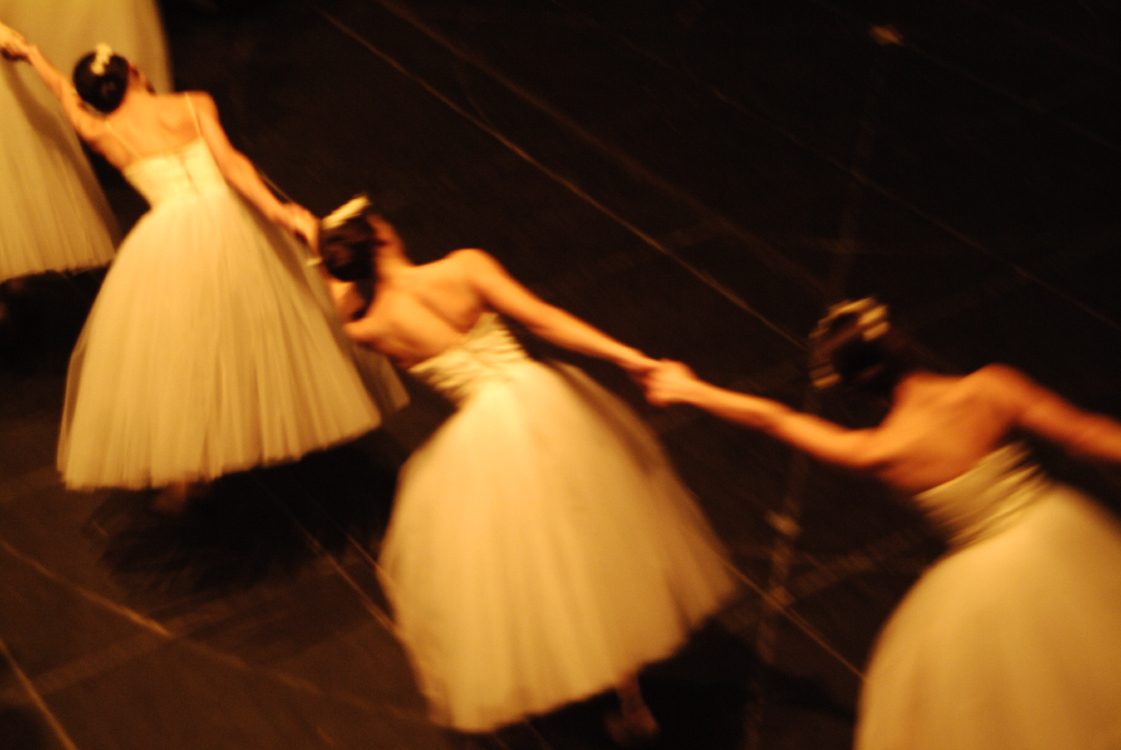 Dance~The Jewish
Dance~The Jewish